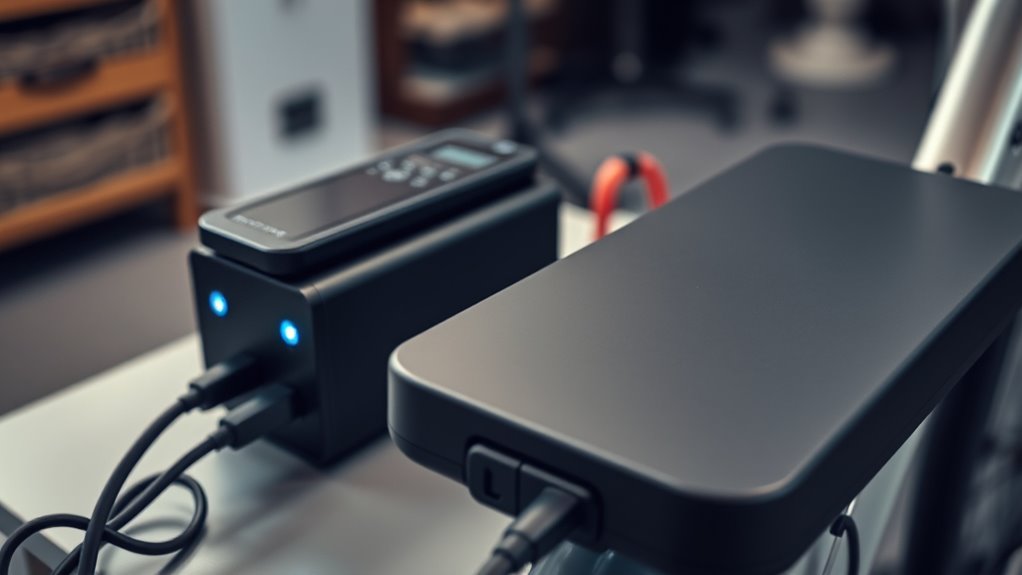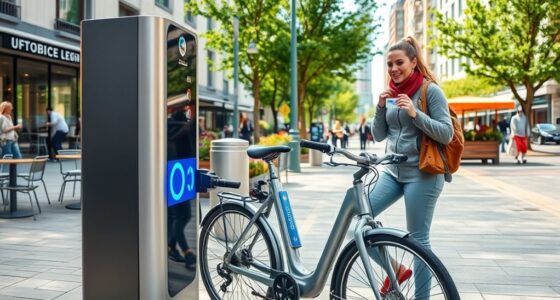To maximize your e-bike battery’s lifespan, keep it charged between 20% and 80%, avoiding frequent full charges or deep discharges. Charge regularly after rides, and disconnect the charger around 80% to reduce strain. Store the battery in a cool, dry place, especially during charging, to prevent capacity loss from heat or cold. By following these best practices, you’ll enjoy reliable performance for years to come—more tips await to help you care even better for your battery.
Key Takeaways
- Keep the battery charge level between 20% and 80% for optimal longevity.
- Charge regularly after each ride, avoiding full discharges to prevent battery stress.
- Use cool, dry environments for charging to protect battery chemistry.
- Limit charging to around 80% to reduce wear and prolong battery life.
- Monitor and avoid deep discharges or leaving the battery at 0% or 100% for extended periods.

Charging your e-bike battery correctly is essential for maintaining its performance and longevity. Proper battery management plays a vital role in ensuring your e-bike remains reliable and efficient over time. One of the key aspects of effective battery management is understanding how charging cycles impact your battery’s health. A charging cycle refers to the process of using a certain percentage of your battery’s capacity before recharging it. For example, using 50% of the battery and then recharging counts as half a cycle. Recognizing how these cycles accumulate helps you avoid unnecessary wear and tear, preserving the battery’s capacity for longer periods.
Most e-bike batteries are designed to handle a specific number of charging cycles—typically between 300 and 500—before their capacity begins to decrease noticeably. To maximize the lifespan, you should aim to keep your battery within a moderate range of charge levels, ideally between 20% and 80%. Frequently charging from very low levels to full can accelerate the aging process, reducing the total number of cycles your battery can withstand. Conversely, avoiding frequent partial charges can also be beneficial. Consistently topping off your battery without deep discharges helps maintain its internal chemistry, ensuring it performs at its best over time.
Keeping your e-bike battery between 20% and 80% extends its lifespan.
Another important aspect of battery management is being mindful of how often and how you charge your battery. Instead of waiting until the battery is completely drained, charge it regularly, preferably after each ride, to prevent deep discharges. Partial charging is not only acceptable but preferable for extending the overall battery life. It’s also wise to avoid leaving your battery at 0% or 100% for extended periods, as this can cause stress on the cells and lead to faster degradation. Instead, aim to disconnect the charger when your battery reaches around 80%, and recharge when it drops to about 20%. This practice helps reduce the strain on the battery’s internal components and preserves its capacity.
Temperature management also ties into good battery management. Charge your e-bike in a cool, dry place, avoiding extreme temperatures that can negatively affect the battery’s chemistry. High heat during charging can accelerate capacity loss, while cold temperatures can temporarily reduce performance. By following these practices—monitoring charging cycles, avoiding deep discharges, and maintaining proper temperature—you’ll ensure your e-bike battery remains healthy for as long as possible. Properly managing your battery not only saves you money in the long run but also guarantees a more reliable, consistent riding experience. Additionally, understanding the importance of battery chemistry can help you better care for your battery and prolong its lifespan.
Frequently Asked Questions
Can I Leave My E-Bike Plugged in All the Time?
You shouldn’t leave your e-bike plugged in all the time because it can affect battery maintenance and reduce overall battery life. Constant charging can lead to overcharging, which stresses the battery and shortens its lifespan. Aim to keep your battery between 20-80% and avoid frequent full charging cycles. Unplugging once fully charged helps maintain ideal charging cycles, ensuring your battery stays healthy and lasts longer.
How Does Temperature Affect E-Bike Battery Charging?
Think of your e-bike battery as a delicate flower that thrives in just the right climate. Temperature greatly impacts charging; too hot or cold can damage it. Thermal management helps keep the charging temperature ideal, preserving battery health. When it’s too cold, charging slows or becomes unsafe, while excessive heat accelerates wear. Keep your battery in a moderate environment, ensuring proper thermal management, to extend its lifespan and maintain peak performance.
Is It Safe to Use Third-Party Chargers?
Using third-party chargers can be risky because they might not match your e-bike’s charger compatibility, which can damage your battery or reduce its lifespan. Always check if the charger is compatible with your bike model to avoid voiding your battery warranty. Stick to the original charger or a certified alternative endorsed by the manufacturer to guarantee safe charging and preserve your battery’s health and warranty coverage.
Should I Fully Discharge My Battery Before Recharging?
You shouldn’t fully discharge your e-bike battery before recharging. Doing so can harm its lifespan. Instead, perform occasional battery calibration by allowing it to discharge to around 10-20%, then recharge fully to stabilize voltage. This process helps with voltage stabilization and maintains accurate battery readings. Regular partial charges prevent deep discharges, which can cause long-term damage, ensuring your battery stays healthy and performs *ideal* over time.
How Do I Store My E-Bike Battery Long-Term?
When storing your e-bike battery long-term, you should keep it at about 50-60% charge in a cool, dry place. For example, a rider stored their battery in a basement, ensuring it was unplugged and checked monthly. This prevents voltage fluctuations and maintains battery calibration, which helps stabilize voltage levels. Avoid full charges or discharges, as these can damage the cells and reduce battery lifespan over time.
Conclusion
By following these e-bike battery charging tips, you’ll enjoy longer rides and fewer replacements. Think of it like nurturing a delicate plant—you want to give it just the right care to thrive. Ignoring best practices might seem convenient at first, but it’s like running on empty; eventually, your battery’s performance will suffer. So, treat your battery with care, and it’ll reward you with reliable power and extended lifespan, keeping your adventures going strong.









